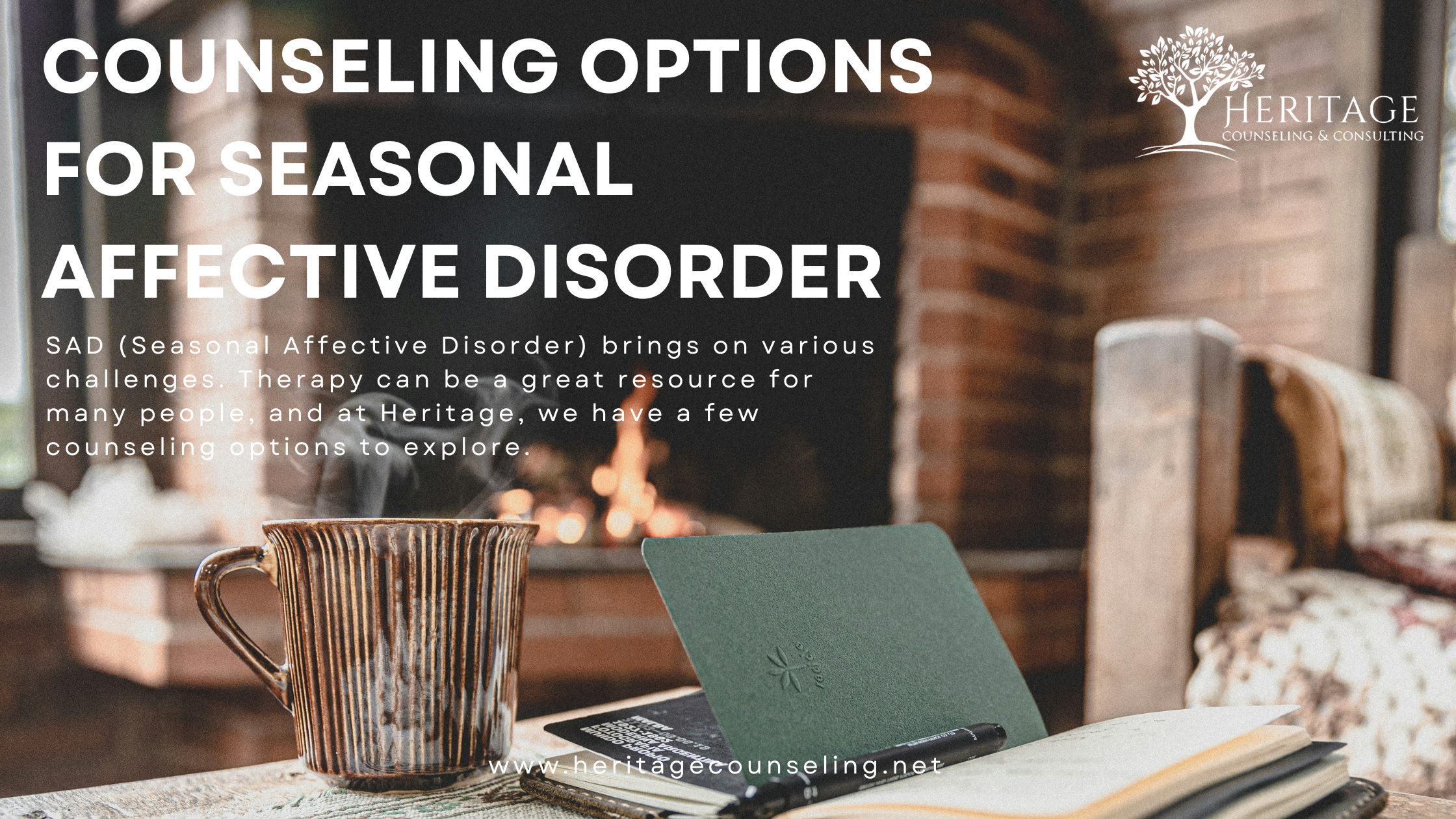Seasonal Affective Disorder (SAD), often referred to as seasonal depression, is a type of mood disorder that follows a seasonal pattern. It typically occurs during the fall and winter months when daylight hours decrease and sunlight exposure is limited but is not exclusive to the winter months. This condition can significantly impact an individual's mental well-being, leading to symptoms such as fatigue, irritability, difficulty concentrating, and changes in sleep patterns. Many people may experience symptoms of SAD and refer to the “winter blues” or experience significant changes in emotional experience, mood, and behavior patterns (NIMH, 2024).
Seasonal Affective Disorder is characterized by the onset of depressive symptoms that coincide with specific seasons, particularly fall and winter (Hopkins Medicine, 2024). It is considered a subtype of major depressive disorder with a seasonal pattern. The exact cause of SAD is not fully understood, but it is believed to be linked to changes in sunlight exposure affecting the body's internal clock, or circadian rhythm, and serotonin levels. The prevalence of Seasonal Affective Disorder varies depending on geographical location, with higher rates observed in northern latitudes where there is less sunlight during the winter months. According to research, millions of people experience Seasonal Affective Disorder each year, and it is often more common in women than men (NIMH, 2024).
Counseling has shown effectiveness in treating Seasonal Affective Disorder. Cognitive Behavioral Therapy focuses on identifying and changing negative thought patterns and behaviors associated with depressive symptoms. In the context of SAD, counseling can help individuals develop coping strategies, set realistic goals, and improve their overall mental well-being.
Seasonal Nature of Symptoms and Contributing Factors
One key characteristic of SAD is the recurrence of symptoms during specific seasons. Individuals with SAD may experience depressive episodes during fall and winter, while their mood improves during spring and summer. Environmental triggers, such as overcast skies and limited sunlight, play a significant role in exacerbating SAD symptoms. The lack of natural light can disrupt the body's internal clock and negatively impact mood-regulating neurotransmitters.
Other triggers may include changes in temperature, reduced outdoor activities, and altered social rhythms. The symptoms often include low energy, persistent sadness, changes in sleep patterns, weight gain, and difficulty concentrating.
Low Energy and Fatigue:
Individuals with SAD often report feeling persistently tired and lacking in energy. This fatigue may make even simple tasks feel more challenging.
Persistent Sadness and Low Mood:
A predominant symptom of SAD is a persistent feeling of sadness or low mood. This emotional state may interfere with the ability to experience joy or pleasure in usual activities.
Changes in Sleep Patterns:
SAD can disrupt sleep patterns, leading to difficulties falling asleep or staying asleep. Some individuals may experience increased sleep duration, while others may face insomnia.
Weight Changes:
Changes in appetite and weight are common symptoms of SAD. Some individuals may experience increased cravings for carbohydrates and sugary foods, leading to weight gain during the fall and winter months.
Difficulty Concentrating:
Cognitive difficulties, such as trouble concentrating and making decisions, are common in individuals with SAD. This can impact work, school, and daily activities.
Social Withdrawal:
SAD may contribute to a desire to withdraw from social activities. Individuals may feel less motivated to engage with others, leading to social isolation.
Irritability and Increased Sensitivity:
Irritability and heightened sensitivity to stressors are additional symptoms of SAD. Small stressors that might not typically be bothersome can become more challenging to handle.
Loss of Interest in Activities:
Individuals with SAD may lose interest in activities they once enjoyed. Hobbies, social events, and other sources of pleasure may no longer bring the same satisfaction.
Feelings of Hopelessness:
Feelings of hopelessness and a pessimistic outlook on the future are emotional symptoms that can accompany Seasonal Affective Disorder.
Physical Symptoms:
Some individuals may experience physical symptoms such as headaches or stomach aches, which can be related to the overall impact of SAD on mental and physical well-being.
It's crucial to recognize these symptoms and seek professional help if they persist or significantly interfere with daily functioning. If you or someone you know is experiencing symptoms of Seasonal Affective Disorder, consulting with a mental health professional can provide guidance and support in managing and treating the condition.
Several factors contribute to the development of Seasonal Affective Disorder. Reduced exposure to sunlight can disrupt the body's internal clock and lead to imbalances in neurotransmitters such as serotonin and melatonin. Additionally, genetic factors, hormonal changes, and a history of other mood disorders can increase the susceptibility to SAD.
Benefits of Seeking Counseling for Seasonal Affective Disorder
Counseling serves as an effective therapeutic approach by addressing both the emotional and behavioral aspects of SAD (Mayo Clinic, 2024). Here are some ways in which counseling can be beneficial for individuals with SAD:
Identifying Negative Thought Patterns:
Cognitive-behavioral therapy focuses on identifying and challenging negative thought patterns that contribute to depressive symptoms. This can be especially relevant for individuals with SAD who may experience a shift in mood during the fall and winter months.
Behavioral Activation:
Counseling helps individuals develop strategies for behavioral activation, encouraging engagement in activities that bring a sense of pleasure and accomplishment. This is important for combating the tendency to withdraw from social and enjoyable activities, which can be common in SAD.
Setting Realistic Goals:
Therapists work with individuals to set realistic and achievable goals, considering the challenges posed by Seasonal Affective Disorder. Breaking down tasks into smaller, manageable steps can be empowering for individuals experiencing SAD symptoms.
Developing Coping Strategies:
Coping strategies are an integral part of counseling for SAD. Therapists assist individuals in developing effective coping mechanisms to deal with stressors related to seasonal changes, mood fluctuations, and the impact on daily functioning.
Light Therapy Integration:
In some cases, therapists may incorporate discussions and strategies related to light therapy, a common treatment for SAD. Counseling can help individuals adhere to light therapy routines and address any challenges or concerns related to its implementation.
Improving Sleep Patterns:
Given that disruptions in sleep patterns are common in individuals with SAD, counseling can address sleep hygiene and promote healthier sleep habits. This contributes to overall well-being and mood regulation.
Exploring Root Causes:
Counseling sessions provide a safe space for individuals to explore underlying issues or stressors contributing to their Seasonal Affective Disorder. Understanding these factors can be crucial for developing targeted interventions.
Emotional Support and Validation:
Counseling offers emotional support and validation for the individual's experiences. It provides a non-judgmental space for expressing feelings, fears, and challenges associated with SAD.
Counseling can contribute to improved mood, enhanced coping skills, and a better overall quality of life for individuals affected by SAD. If you or someone you know is experiencing symptoms of SAD, consulting with a mental health professional can provide personalized guidance and support.
Types of Therapy for Seasonal Affective Disorder
Cognitive-Behavioral Therapy (CBT):
CBT is a widely recognized and effective form of counseling for Seasonal Affective Disorder. This therapeutic approach focuses on identifying and challenging negative thought patterns and behaviors associated with SAD. By restructuring cognitive patterns and implementing coping strategies, individuals can develop healthier perspectives and better manage symptoms.
Light Therapy and Counseling Integration:
Light therapy, a common treatment for SAD involving exposure to a bright light that mimics natural sunlight, can be complemented with counseling. Combining light therapy with counseling sessions allows individuals to explore the emotional and psychological aspects of their experience with a mental health professional, fostering a more holistic approach to treatment.
Also known as EEG (electroencephalogram) biofeedback, Neurofeedback therapy is a therapeutic technique that involves real-time monitoring of brainwave activity to teach self-regulation of brain function. Some research and anecdotal evidence suggest that neurofeedback may have potential benefits for certain individuals with mood disorders (Hammond, 2016).
Interpersonal Therapy (IPT):
IPT focuses on improving interpersonal relationships and communication patterns, making it particularly relevant for Seasonal Affective Disorder. Individuals may explore how the change in seasons affects their social interactions and relationships. IPT aims to enhance communication skills and address interpersonal issues contributing to SAD symptoms.
It's important to note that the choice of counseling for Seasonal Affective Disorder may vary based on individual preferences, the severity of symptoms, and the specific challenges faced. A mental health professional can tailor counseling approaches to meet the unique needs of each individual, providing valuable support and guidance in managing Seasonal Affective Disorder effectively.
In conclusion, Seasonal Affective Disorder is a significant mental health condition that affects individuals in a seasonal pattern, with symptoms typically worsening during fall and winter. Understanding the prevalence, contributing factors, and environmental triggers can help individuals recognize and address SAD. Seeking counseling, particularly cognitive-behavioral therapy, can be a valuable therapeutic approach, providing individuals with the tools and support needed to manage symptoms and improve their overall mental health. If you or someone you know is experiencing symptoms of Seasonal Affective Disorder, consider reaching out to Heritage Counseling and Consulting at 214-363-2345 to work with a qualified mental health professional. We are proud to offer high-quality and effective counseling and Neurofeedback interventions.
Sources:
https://www.isnr-jnt.org/article/view/16553 (Hammond, 2016)

